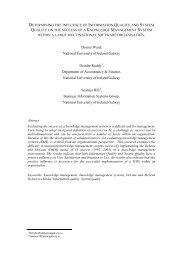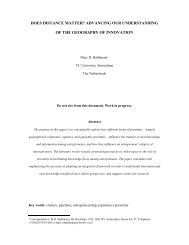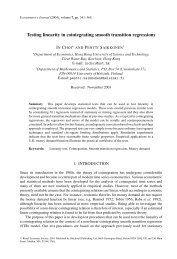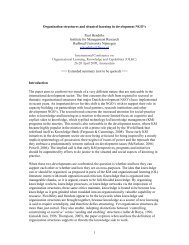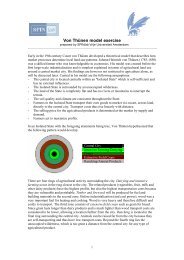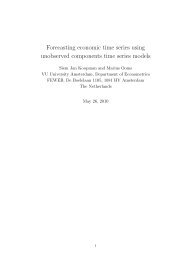The effects of road pricing - Feweb - Vrije Universiteit Amsterdam
The effects of road pricing - Feweb - Vrije Universiteit Amsterdam
The effects of road pricing - Feweb - Vrije Universiteit Amsterdam
Create successful ePaper yourself
Turn your PDF publications into a flip-book with our unique Google optimized e-Paper software.
Common and joint costs<br />
A related set <strong>of</strong> <strong>pricing</strong> complications occurs because transportation firms <strong>of</strong>ten use<br />
the same facilities, equipment and labour to produce different services: they are multiproduct<br />
firms. This leads to the conceptual and practical problems <strong>of</strong> determining<br />
transport prices associated with fixed and variable costs and choosing the relevant<br />
time period because many costs may also be ‘joint’ or ‘common’ to a number <strong>of</strong><br />
users. Pricing in these circumstances may be difficult, as it is not always clear how to<br />
allocate costs between products. This may make it difficult to determine marginal<br />
costs. Joint costs exist when the provision <strong>of</strong> a specific service necessarily entails the<br />
output <strong>of</strong> some other service or product at little extra expense (Gomez-Ibanez, 1999).<br />
Jointness is a technical feature and exists at all points in time, that is, both before and<br />
after investment or capacity decisions are made. <strong>The</strong> classic example <strong>of</strong> jointness is<br />
the return trip, where the supply <strong>of</strong> a transport service in one direction normally<br />
implies the provision <strong>of</strong> a return service (Button, 1993).<br />
Common costs are similar to joint costs, in that they are incurred as a result <strong>of</strong><br />
providing services to a wide range <strong>of</strong> users, but differ, in that the resources used to<br />
provide one service do not unavoidably result in the production <strong>of</strong> other services<br />
(United Nations, 2001). An airport, for example, faces considerable common costs. A<br />
terminal is used by different types <strong>of</strong> users: terminal retailers and air passengers. <strong>The</strong><br />
same holds for runways, these are used by different types <strong>of</strong> planes. <strong>The</strong> allocation <strong>of</strong><br />
these common costs among users poses particular practical problems, which<br />
consequently also leads to <strong>pricing</strong> problems.<br />
2.4.4 Monopoly<br />
Firms facing the previous mentioned aspects such as high fixed costs and economies<br />
<strong>of</strong> scale, together with significant indivisibilities in the provision <strong>of</strong> capacity, have<br />
limited competition. <strong>The</strong>se circumstances, <strong>of</strong>ten the case in the transport industry<br />
(particularly in terms <strong>of</strong> infrastructure), give rise to monopolies. Under these<br />
conditions, and a fairly small transport market relative to the optimal size, a good or a<br />
service can only be produced at least cost if only one firm is engaged in its production<br />
and a natural monopoly is likely to emerge. Public transport companies are <strong>of</strong>ten<br />
claimed to be a natural monopoly, although there may be little evidence <strong>of</strong> scale<br />
economies (Gomez-Ibanez, 1999). Constraints on competition are intended to avoid<br />
certain problems, but this tends to increase costs and does not provide an incentive for<br />
the development <strong>of</strong> alternatives, such as demand response transport and premium<br />
service commuter buses. A more competitive transport market may therefore result in<br />
benefits to consumers.<br />
Imperfect competition creates a major distortion in the market for transport services.<br />
<strong>The</strong>re is every risk that the monopolist will not provide optimal transport prices and,<br />
an unregulated market will therefore not lead to the maximisation <strong>of</strong> social welfare. In<br />
such circumstances, the government may decide to intervene either by directly<br />
providing the transport services or by regulating prices.<br />
Hence, it is unlikely that prices equate marginal social costs under conditions <strong>of</strong><br />
monopoly. Figure 2.4 illustrates how price and output would be determined under<br />
conditions <strong>of</strong> monopoly, and under competition within an industry subject to<br />
declining costs (e.g. the transit industry). <strong>The</strong> monopolist aiming to maximise pr<strong>of</strong>it<br />
will expand output up to the point at which marginal revenue is equal to marginal cost<br />
– point a in Figure 2.4. <strong>The</strong> corresponding level <strong>of</strong> output, QM, leads the monopolist<br />
to charge a price <strong>of</strong> PM and supply the market at an average cost <strong>of</strong> CM. <strong>The</strong> pr<strong>of</strong>it<br />
24





